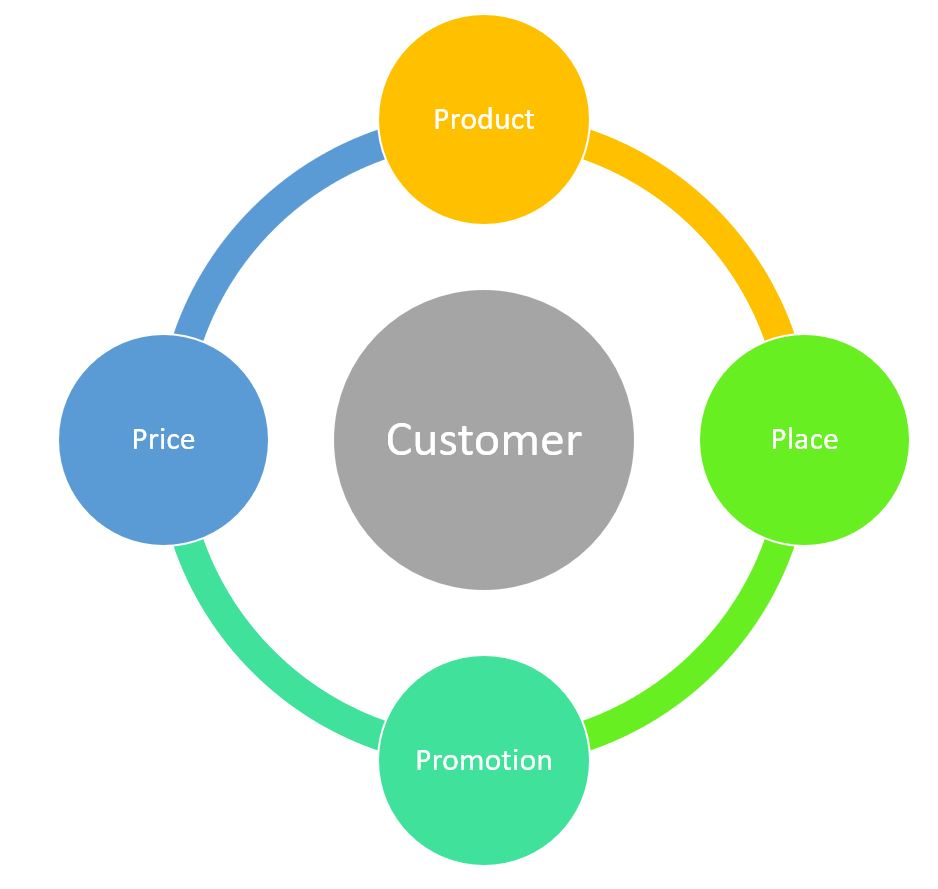
Marketing is as old as mankind: You have an offer that someone else should accept. A market-oriented offering – an ice cream truck at the beach on a hot summer day – is successful marketing when combined with a strong sales model, while selling sand in the desert will be challenging.
The daily routine shows us that success comes down to basic principles. Because ultimately, marketing means creating concepts for marketable offers through holistic corporate management and strategically placing them in the market to increase sales – and image.
Familiar are the ‘4 P’s’ in Marketing, and often overlooked is the ‘C’, but more on that later.
In marketing, one must:
- Understand the market
- Set marketing goals
- Recognize needs of customer groups
- Create promising products or develop good sales arguments
- Identify target audiences and channels
- Develop inspirational messages
- Come up with and implement (= the hardest part) marketing measures
- Check results and reconsider marketing measures if necessary
Content
- What is Marketing? The AMA Definition
- How does Marketing works? Together with Sales
- What are the four Ps of the Marketing Mix? It's actually 4P + C!
- These are the original four P's + C of marketing according to McCarthy:
- Uncontrollable factors in Marketing
- What is the Unique Selling Proposition (USP)?
- Conclusion
What is Marketing? The AMA Definition
Should you seek a definition for marketing, head over to the birthplace of modern marketing: the United States. As per the American Marketing Association (AMA) – the guardians of marketing stateside – marketing is defined as follows:
Marketing is the activity, set of institutions, and processes for creating, communicating, delivering, and exchanging offerings that have value for customers, clients, partners, and society at large.1
AMA, 2017
One thing is clear: Successful marketing centers around promoting offers with real value. This approach emphasizes the customer experience, deeply ingrained in American culture (keyword: service mentality). Often in Europe, we sometimes still focus either on engineering brilliant products that aren’t adequately explained, or resort to pushing out mediocre products just to make quick cash – something seen worldwide, and totally understandable, as making money makes a happy camper.
The key lies in identifying and incorporating this added value into the product beforehand or creatively devising its benefits post-production, particularly useful when dealing with quirky products.
Notably, the term “value for the society at large” may catch your attention. Though seemingly vague, it subtly hints towards sustainability and Environmental Social Governance (ESG), making this definition of marketing quite forward-thinking.
How does Marketing works? Together with Sales
At first glance marketing seems simple: Through targeted actions, including advertising, marketing improves the sale of goods and services. Meanwhile, sales handles the transactional aspect. But if marketing and sales don’t collaborate effectively, it looks bad. Therefore, marketing works only as part of a team effort with sales.
To stay with our fictional example of ice cream: If the marketing department decides to promote the ice cream brand during the daytime in a pedestrian zone, which would naturally be empty at a seaside location, then sales might complain about low sales figures due to customers not knowing or trusting the unfamiliar brand compared to established competitors.
This serves as a great transition to the widely recognized four Ps in marketing.
What are the four Ps of the Marketing Mix? It’s actually 4P + C!
The Four Ps in marketing are well known, however, what is almost always forgotten is that here 4P + C applies. The C stands for Customer.
The Marketing Mix encompasses a range of instruments used to achieve marketing objectives.
The four Ps, which originate in their current form from E. Jerome McCarthy, professor at Notre Dame, come from the 760 page book Basic Marketing: A Managerial Approach[1] published in 1960. And because much information found online is copied from other sources without proper research, I linked the primary source as a full text scan from HathiTrust (supposedly public domain). By the way, the book reads easily and smoothly, quite enjoyable

These are the original four P’s + C of marketing according to McCarthy:
- Product
- Place
- Promotion
- Price
- And at the very center: Customer
By the way, this order is the actual order – pricing only comes last!
These four elements are closely interconnected and influence each other. According to McCarthy, when considering 100 possible options for each P, it results in 100 million potential different marketing strategies.
It is important to note that the four P’s cover exactly the space of controllable factors in the Marketing Mix.
However, uncontrollable factors such as societal and economic dependencies are equally important to consider, especially since your company deals with many of these factors.
Above all, the C factor tends to be neglected. Don’t do it.
1. Product
In the field of product policy, the objective revolves around crafting the ideal product tailored to the target audience: What product shall I choose for this purpose? How should I brand it, what kind of corporate identity should I adopt? How do I design the packaging? Is there a unique selling proposition (USP)?
Using the ice cream example: Should I sell nerdy cookie-flavored ice cream, or rather mainstream easygoing strawberry ice cream at the beach? Would it benefit me to offer multiple varieties, including vegan options, or stick with fewer choices like classic popsicles? This depends entirely on my defined target segment and local preferences! At “nerd beach” in Foodie Town, a local, craftsy approach might be perfect.
2. Place
Distribution policy refers to getting the right product to the target customer. Where, when, and by whom they receive access to purchase the product – all that falls under this category. This includes the entire supply chain, covering transport, warehousing, wholesale, retail, and financial services.
Example: How does the ice cream get to the beach? Does it involve multi-level distribution channels? Must I register with wholesalers? How do I maintain the cold chain? Do I operate my own ice cream trucks, or do I rely on independent contractors who remain unknown?
3. Promotion
Communications Policy comprises all measures aimed at reaching the target clientele, ensuring the appropriate product is sold at the correct place and price. Advertising, sales promotion, and possibly building a highly skilled sales force fall under this category. Additionally, in the area of Promotion, it is feasible to produce items solely intended to bundle or repackage existing products differently.
Example: One type of ice cream has always been plant-based due to cost constraints. Yet, it could be promoted as ‘vegan,’ enabling an increased price point compared to previous prices.
4. Price
Setting the right price involves determining the optimal cost for the perfectly matching product at a given location. The price should appeal to the customer and generate profits for the business, unless pursuing a higher market share via loss leaders. Pricing strategies play a significant role in managing brands. Establishing prices isn’t straightforward, as competitors might manipulate prices or adapt them to your prices via AI and algorithms.
Example: Offer discounts to the ice cream truck owner, increasing his revenue, as delicious coastal ice cream aligns perfectly with the brand concept.
C – Customer, often forgotten
„A customer is the boss behind your boss”
It pays to be customer minded. New york: Alumni Publications, Inc., 1955, page 12
As shown in the original chart from the book, a letter “C” occupies the center position. This represents the word Customer. Consequently, the four P’s in Marketing should always be employed with the customer in mind. After all, no business strives without consumers, well, except some gov’t ops. Sometimes, companies misidentify their most vital customer base.
Regarding our ice cream example, the customer in the center is the ice cream truck vendor. In case he purchases ice cream from our competitors, it results in zero sales for us. Thus, creating confidence in our ice cream brand becomes essential to convince the ice cream truck guy from our brand:
a) Our brand resonates positively with end consumers,
b) Our quality is exceptional
c) We give you a generous earnings potential
d) We provide support throughout the journey
Uncontrollable factors in Marketing
As a marketing manager, controlling variables is crucial; however, complete control ain’t not gonna happen. External influences can capsize any marketing strategy. Examples of such factors include economic conditions, cultural shifts, social transformations, and even corporate structures. While some things change gradually, others happen suddenly, punctuated occasionally by disruptive competitors entering the scene.
To minimize uncertainty, marketers analyze macroeconomic indicators and review empirical findings from sociological and market research studies
What is the Unique Selling Proposition (USP)?
A Unique Selling Proposition (USP) signifies the distinctive advantage of a product or service. To discover the USP, consideration of all four Ps – including the customer – or venturing into product development is required. During brand creation, integrating the brand itself as a partial USP proves viable if the brand exhibits sufficient strength.
Example: Regarding our ice cream, let’s think of “cheap pricing” as the USP. Such an USP holds little merit at the ice cream truck where the vendor sets the price, potentially causing inflated costs. Instead, a genuine USP could be created by producing an ice cream perfect for the beach, owing to specially designed packaging preventing rapid melting and dripping.
Conclusion
Effective marketing plays an indispensable role in businesses seeking goal achievement. Both offline and digital marketing adhere to these fundamental principles. Within the Marketing Mix, the time-tested four Ps serve as valuable guidance; nonetheless, disregarding the “C” for Customer risks rendering them irrelevant.
Hence, prioritize the customer satisfaction above all else. Accomplishing this requires attractively articulating the customer value proposition using professional expertise. With refined messaging, captivating your target audience becomes attainable.
Interested in marketing support? Contact me

About the Author
Stefan Golling, Cologne, Germany. Worked since 1998 as a Copywriter and Creative Director in (Network) Agencies and freelances since 2011 as German Freelance Copywriter, Marketing Freelancer, Creative Consultant etc., e.g., in international projects.
[1]McCarthy, E.J., Basic Marketing: A Managerial Approach. Irwin, Homewood, Ill., 1960
[2] https://babel.hathitrust.org/cgi/pt?id=inu.30000041584743&seq=63
Read similar articles
- Claude: What Can Anthropic’s AI Do?

- ChatGPT: Overview, use GPTs, alternatives

- Transcreation requires courage

- AI Consultant: What a professional can do for you

- Sustainability Copywriter: Expert or Allrounder?

- What is Marketing? The real 4 P’s (including “C”)

- Chat GPT: Plus? No. Team? Yes. 2 reasons

- Advertising Agency in Germany – or a Freelancer?

